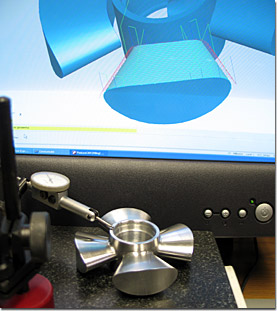 Magnets & Materials Overview
Magnets & Materials Overview
Links
- Making Magnets – An audio slideshow on our resistive magnet shop.
- Latest Research – Instrument- ation for Measurement of Strain Dependence of Nb3Sn Conductors (PDF)
Magnets and materials go hand-in-hand, as the push for ever higher magnetic fields requires not just engineering excellence with what is already available, but also the development of new materials and especially their understanding and development in new product forms. The Magnet Lab is a national resource in both arenas, home to the Magnet Science & Technology (MS&T) group and the renowned Applied Superconductivity Center (ASC), the latter of which joined the Magnet Lab as a division in 2006. The present goals of the Lab – to develop the world’s most efficient hybrid magnets and the world’s strongest superconducting magnets – require forefront magnet and materials engineering that are being supplied by both divisions working in tandem.
 Interior hardware required for a split coil magnet system in a neutron scattering facility, generated from a design software model by the MS&T team.
Interior hardware required for a split coil magnet system in a neutron scattering facility, generated from a design software model by the MS&T team.
MS&T
The MS&T division is charged with developing the technology and expertise for cutting-edge magnet systems. These magnet projects include building advanced magnet systems for the Tallahassee and Los Alamos sites, working with industry to develop the technology to improve high-field magnet manufacturing capabilities, and pushing the state of the art beyond what is currently available in high field magnet systems through research and development. You can explore more about the R&D efforts using the links at left. In addition to designing, building, maintaining and improving the lab’s onsite magnets, MS&T contracts with other universities and national and international labs to design one-of-a-kind magnet systems.
The magnet development facilities in Tallahassee include 11,000 square feet of space for fabrication, assembly and maintenance of resistive magnets. Pulsed magnet development is housed at the lab’s Pulsed Field Facility in Los Alamos. Magnet science and technology efforts are supported by magnet development facilities established and maintained within the Mag Lab. These include coil fabrication areas, test and analysis laboratories and material development facilities.
For more information contact MS&T Director and Chief Engineer Mark Bird.
ASC
The Applied Superconductivity Center advances the science and technology of superconductivity by understanding and pushing the limits of both the low temperature niobium-based and the high temperature cuprate or MgB2-based materials. Focusing heavily on understanding and exploiting the interface between the “R” and the “D” in R&D, the ASC pursues the superconductors needed for everything from magnets for fusion, high energy physics, MRI, to electric power transmission lines and transformers. ASC and MS&T have particularly strong collaborations on the new push to solenoid magnets at fields of 25T and above using cuprate, high-Tc conductors such as Bi2Sr2CaCu2Ox and YBa2C2vO7-x and the understanding of how best to design Nb3Sn conductors for very high current density and mechanical strength for cable in conduit applications like the Fusion Reactor ITER and the series connected hybrids of MS&T. ASC reports directly to the lab director. For more information contact ASC Director and Chief Materials Scientist David Larbalestier or Scholar/Scientist Peter Lee.








